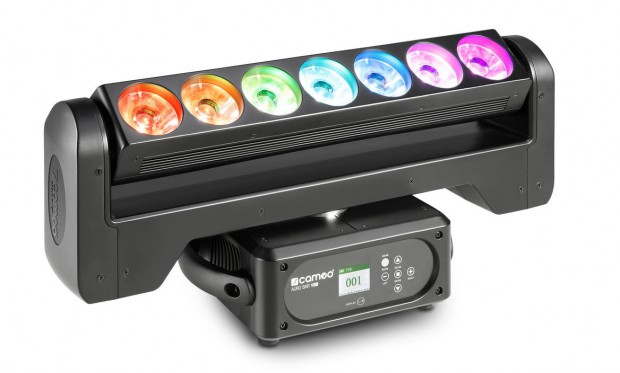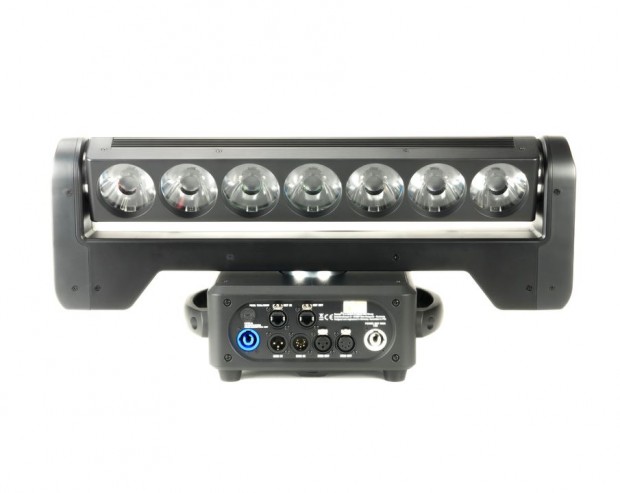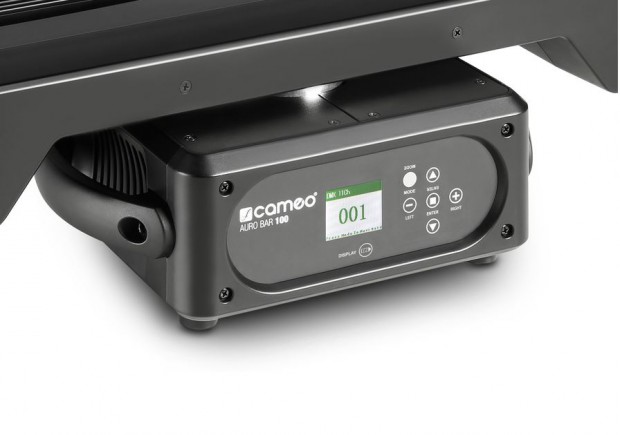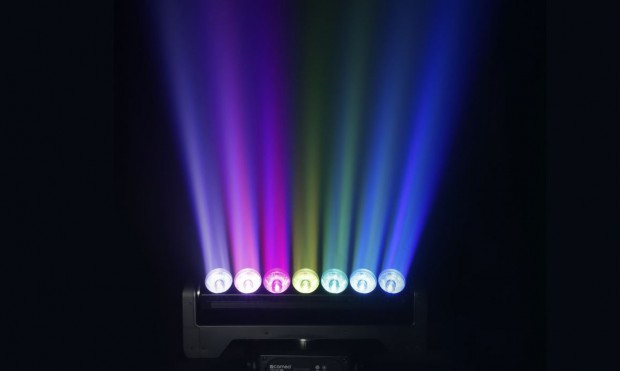Cameo Auro Bar 100 – Test Report by bonedo.de
With its combination of light efficiency and professional roadworthy handling, the Cameo Auro Bar 100 makes its presence felt. Its many user-friendly features and details have undoubtedly been implemented by live- and production-proven engineers: High light output, TV-compatible refresh rate, ArtNet-compatibility and convection cooling are just a few of this compact light unit’s outstanding features. It is fascinating how much can be coaxed from a single bar. If it is combined with a few more units, then things really start moving – literally!

Details
First of all, the basics: The Cameo Auro Bar 100 is equipped with 7 individually controllable 15-watt quad-LEDs, giving an assertive light output. However, the amount of light does not automatically equate to the quality of light. But here it does: The bar features 16-bit resolution and the colour spectrum covers the whole RGBW spectrum, including pastel colours and three white tones. These can be mixed to create rich contrasts, and thanks to its beam angle of 4 degrees, the bar can be perfectly aligned. With the appropriate menu setting, the bar can also be used as a wash-light on a traverse or to flood specific areas.
However, the preferred task of the Auro Bar is to create moving fascination. To achieve this, the unit delivers a light output of 42,000 lux @ 1m with infinite pan and tilt. To ensure that it works correctly in complex setups and DMX universes, it features an ArtNet connection, convection cooling and much more. Nor has Cameo skimped on the refresh rate: At 3,600 Hz, the professional spotlight meets the requirements of TV and video productions.



Unconventional design for exceptional scenes
The combination of its small chassis and slightly oversized LED bar alludes slightly to a helicopter. While the actual ‘brains’ of the unit – including the pan and tilt motors – can be found in the base, the rotating light bar is installed in a generously proportioned boom. The LEDs are positioned symmetrically adjacent to each other on the bar. All housing components are made of ABS plastic or metal. Omega clamps for stand- or traverse-installation are included. The robust composite housing is also equipped with feet, so it can be positioned on the ground or the LJ-console.
Power by magic – battery-powered display
The touch-buttons and the easily readable LC display are located on the front of the chassis. It is equipped with a battery backup, so the bar can also be programmed without a mains connection. Simply press and hold the corresponding button for 4 seconds and you can configure the unit in its case prior to installing it on the large stage.
Connections: Well thought-out back of the light also a delight
The control panel on the rear chassis (which is the front and which is the back?) accommodates three- and five-pin DMX-ins and outs. There are also ArtNet-compatible RJ-45 jacks, Neutrik PowerCon power connection sockets and the fuse-holder. As usual from Cameo, the connection panel is slightly recessed. This aids device safety and minimises problems caused by damaged cables during live operation.
RDM – convenient editing and administration
At this point it is worth mentioning the RDM capabilities of the unit. Indeed, with this contemporary feature, status queries and configuration can be carried out via an external RDM controller. The controller then becomes the decisive component during setup, for convenient, contemporary remote device control. However, please note that such a controller is not supplied with the Auro Bar 100.
Enjoy the diversity – into the depths of control and setup
Let us address the question of what the Cameo Auro Bar 100 can do. A look at the menu is required. It is opened via the touch button labelled Mode. You can rotate the display beforehand through 180°by pressing the “+” button. This has become a common solution to facilitate readability during rigging.
The menu tree opens with a touch of the Mode button. In descending order are: DMX address, Mode, Settings, Network Settings and System information. It then continues into the submenus. Four DMX modes are available for DMX connection. The Auro Bar 100 is controllable by 9, 19, 29 or 39 DMX channels. Used as a standalone device, the eight factory-installed auto-run programmes create attractive scenes. Additional ones can be freely programmed.
And incidentally: A variety of device profiles for different light programmes can be downloaded from the Cameo website.
Remove distraction – a useful detail
No sensation, but appropriate for stages and good to know: The display can be switched off! Unfortunately, it is sometimes forgotten that an illuminated display can, of course, also be seen by the audience. As you know, the simplest solutions are usually the best, so the display can be disabled during the show. As soon as the Auro Bar is connected to control software, the display is no longer required anyway.
As complex as it is simple – configuration
It gets interesting in Network Settings. As already mentioned, the light unit is ArtNet-compatible. The IP address, the subnet mask and the DMX universe are displayed or named under this menu item. The Cameo Auro Bar 100 can be quickly incorporated into a wide range of different setups. The configuration and editing options are standard, only becoming comprehensive in DMX mode.
In addition to the usual parameters, four different dimmer curves can be selected. They provide increasing or decreasing light intensity with linear, exponential, logarithmic and S-curve options. A feature that facilitates particularly subtle or aggressive changes of ambience. It configures DMX addresses, motion sequences, strobe speed, colour temperatures, pan, tilt and other normal parameters, the majority of them seamlessly.
Fascination by light and darkness
Mov Blackout provides a scenic enhancement. Here, head movements are used to select between on and off for an instant blackout. This provides a whole host of creative options. Simply cool, when the spots are lit in one location, disappear imperceptibly and reappear out of nowhere in an unexpected location with a different tilt angle.
A little tip in passing: Anyone wishing to familiarise themselves with the multilingual operating instructions should download the online version. The enclosed paper version is identical, but its minuscule print is better suited to eagle eyes.
In use
The LED bar can do anything – from slow moves in sync and in harmony with the music to fast and furious bombast with strobe flashes. And as long as the scene is pre-programmed with appropriate timing, it always surprises. For example, if a white strobe is flashing in a vertical position, you can suddenly stop it for a ‘still’ moment, and then the spot can reappear from the darkness at any angle to create colourful scenes in a different location. Do this with several of these units to lend large locations a cinematic geometric harmony. It is great fun to work with this unit, which allows limitless possibilities for customised light compositions.
The two three-phase electric motors move the light bar rapidly and precisely to its positions. This is supported by the automatic position control, which gives the operator the ambivalent feeling, that they are slowly becoming obsolete. The position correction can be turned on or off, a detail for specialists. I would leave it on as a matter of course.

Convection cooling for quiet in the hall
The quiet running and low noise are most pleasing. This is also due to the convection cooling. Other than the inevitable rotation or movement sounds from the boom and the motors, there is nothing to hear. So the Cameo Auro Bar 100 can also be used in acoustically sensitive contexts, such as in the theatre or at a trade fair. For this reason, this unit stands out in comparison with others on the market. When movement and speed are brought together, it is not inevitable that things will work really quietly.
Damage with intent – it works
And then the crash test: In order to assess the reliability of the Ethernet switch with FDT-bridging works, I simply pull out the fuse of one of the series-connected lamps. The result: The series circuit remains intact. All of the other lights carry on regardless. The show must go on.
In System info, the operating temperature is displayed, either of the LEDs or of the entire unit. The QUAD LEDs are at a temperature of around 30 to 40 °C at start-up, and continue to get hotter. Convection cooling and cooling fins are activated in a timely fashion and ensure that temperatures remain at a level safe for the unit.
Conclusion (5 / 5)
The concept of the Cameo Auro Bar 100 is concise and to the point. Each component has its purpose, every detail is consistent and provides the required performance. Here, the sum of its parts consistently creates a greater whole. Nothing is over-engineered. In short, this is a moving bar with impressive performance. The Cameo Auro Bar 100 is clearly aimed at professional and semi-professional customers. The price could be a concern for hobby DJs or LJs, especially since the Bar 100 is most effective when used in multiples, but it is worth the investment.
PROS
Powerful light output
ArtNet-compatible
RDM-capable
3,600 Hz refresh rate suitable for TV
Convection cooling
Single pixel control
Automatic FDT-bridging in the event of device failure
Automatic position and colour temperature correction
Battery-buffered display
Low-noise operation
CONS
None
FEATURES
LED Moving Bar with infinite pan and tilt
2 high-speed three-phase motors
16-bit resolution and 3,600 Hz refresh rate
7 x 15 W quad-LEDs
Rich RGBW colours, subtle pastel shades and three whites
4 DMX control modes, RDM-capable and ArtNET-compatible
Ethernet switch with FDT-bridging (maintains series connection even if device fails)
Automatic position and colour temperature correction
Single pixel control
20 Hz strobe and 4 dimmer curves
Beam angle: 4°
DMX input: 3-pin male XLR, RJ45 Ethernet In (ArtNET), 5-pin male XLR
DMX output: 5-pin female XLR, 3-pin female XLR, RJ45 Ethernet Out (ArtNET)
DMX modes: 9-channel, 39-channel, 29-channel, 19-channel
DMX functions: pan/tilt, colour temperature correction, dimmer curve, dimmer, patterns, RGBW colour macro, strobe, auto-programmes, pan/tilt fine
Stand-alone modes: auto run
Controls: value down, -, mode, enter, battery display, value up +
Indicators: colour LC display
Power supply: 100–240 V AC / 50–60 Hz
Power consumption: 140 W
Power connection: Neutrik PowerCon
Housing material: ABS plastic, metal
Housing colour: black
Cooling: convection
Light intensity: 42000 lx @ 1m
Lighting power: 2300 lm
Dimensions W/H/D: 570 x 260 x 195 mm
Weight: 9.5 kg
RRP: 1398 euros











